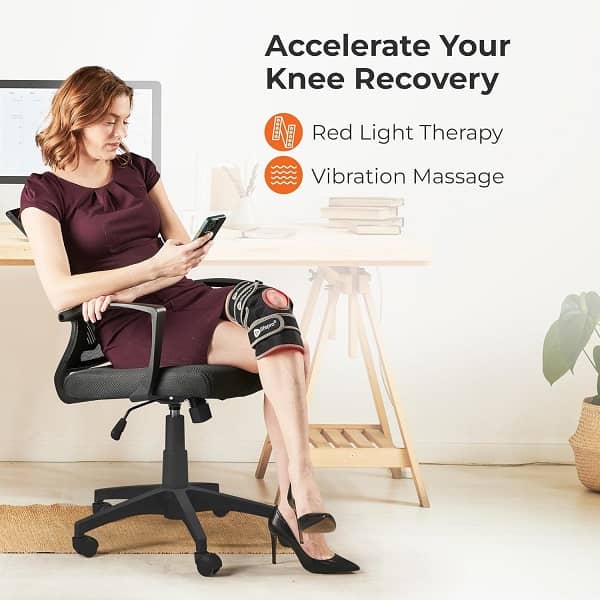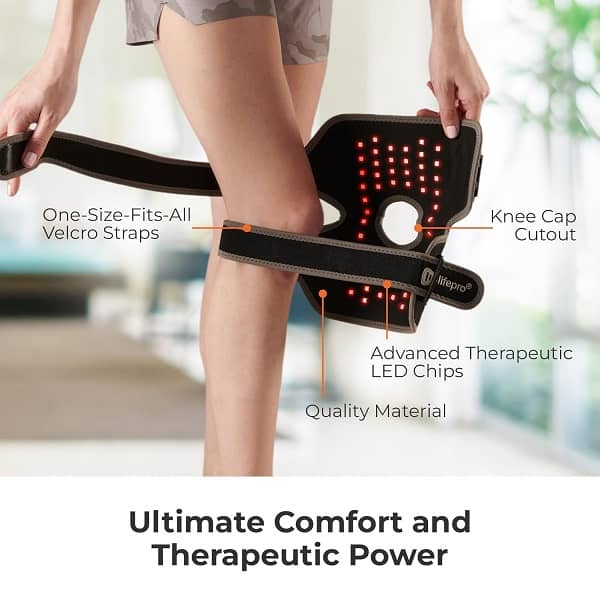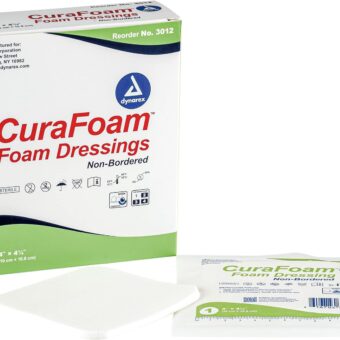Knee pain treatments vary in strategy and technique. This may leave you searching for effective solutions. Red light therapy belts are gaining attention as an innovative approach. These tools penetrate tissues and promote healing. But how effective are these devices for your knee discomfort? This guide will explore the science of red light therapy. We’ll cover its benefits and what to expect from a therapy belt for knee issues. Knowing this treatment can help you decide about your joint health.

Table of Contents
- I. Understanding Red Light Therapy
- II. Types of Red Light Therapy Devices
- III. Effectiveness of Red Light Therapy Belts for Knees
- IV. Tips for Maximizing Red Light Therapy Benefits
- V. Step-by-Step Guide to Using a Red Light Therapy Belt
- VI. Pros and Cons of Using a Red Light Therapy Belt
- What to Consider When Choosing a Red Light Therapy Belt for Knee Care?
- FAQ
Key Takeaways:
-
Pain Relief: Red light therapy belts can reduce knee pain and inflammation. They offer a non-invasive alternative for pain management.
-
Improved Circulation: The therapy boosts blood flow to the area. It helps heal and recover faster after an injury or surgery.
-
A red light therapy belt offers easy operation. You can use it at home. It is a great option for ongoing treatment.
I. Understanding Red Light Therapy
Before diving into how red light therapy can help your knees, you must grasp what this treatment is. It is innovative.
1.1. What does red light therapy involve?
Red light therapy (RLT) is, at its core, exposure to specific wavelengths of light. It claims the red and near-infrared spectrums. RLT aims to heal and regenerate the body. This therapy uses low-level light to boost cellular function. It is popular in clinics and for at-home treatments.
Red light therapy may treat various ailments. These include joint pain, muscle recovery, skin rejuvenation, and mood enhancement. As these apps grow, many see their potential to improve health and wellness.
1.2. How Red Light Therapy Works

Light penetrates the skin. It reaches the underlying tissues. There, it interacts with the mitochondria, the powerhouse of your cells. Absorbing red light triggers biological responses. They boost energy production in cells. This improves their function and repair. This happens through a process called photobiomodulation. It generates energy in the form of adenosine triphosphate (ATP).
Light therapy does more than boost your cells’ energy. Light can boost circulation. It does this by growing new capillaries. They improve nutrient delivery and waste removal. Better energy and circulation are key to faster healing.
Researchers have studied therapy for its benefits in relieving joint pain and inflammation. This is especially true for arthritis and knee injuries. Red light therapy can help reduce pain and stiffness. It targets inflamed areas. This can restore your mobility and lead to a more active life.
1.3. Benefits of Red Light Therapy for Joint Pain
Light therapy offers many advantages for those suffering from joint pain. Its main benefit is its anti-inflammatory properties. It can soothe sore tissue around your joints. It reduces discomfort and helps with recovery and flexibility in the affected areas.
Also, many users report better circulation and joint function from the therapy. Red light therapy increases blood flow to your knee joints. It helps relieve pain and provides vital nutrients. These nutrients aid in tissue healing and regeneration. This may reduce flare-ups and help you be more active.
Red light therapy for joint pain is promising. It is non-invasive. It is a good option for those seeking alternatives to drugs. Its effects build up. So, consistent use can yield long-term benefits. This makes it a practical option for improving your joint health.
II. Types of Red Light Therapy Devices
You may wonder about the types of red light therapy devices available today. Each device has a unique purpose. But, they all aim to harness the healing benefits of red light. Below, we present a quick overview of the most popular devices used for red light therapy:
| Device Type | Features |
|---|---|
| Red Light Therapy Belt | Flexible design for targeted area, hands-free use |
| Handheld Devices | Portable, easy to maneuver, and ideal for spot treatment |
| LED Panels | Covers larger areas, often used in clinics |
| Light Therapy Masks | Specifically designed for facial treatments |
| Near-Infrared Devices | Penetrates deeper tissues for chronic pain relief |
Devices that use red light therapy can vary in size, shape, and usage. From small, portable units to larger panels, each device meets specific treatment needs. For instance, red light therapy belts are popular for their convenience. They let you target areas like your knees while staying hands-free. Meanwhile, people can use handheld devices for precise tasks. They don’t need to stick to a specific body part.
2.1. Red Light Therapy Belts vs. Other Devices

Other red light therapy devices serve various purposes and come with diverse benefits. Handheld devices are best for precise, targeted treatment. LED panels span vast expanses with a great space-saving effect. So, they are better for wider therapy uses. Despite these differences, red light’s effectiveness depends on its wavelength and intensity. It does not depend on the device’s shape or design.
Light therapy belts have a unique advantage: convenience. They encircle sensitive zones, such as the knees, with a snug fit. This allows for consistent treatment without using your hands. This hands-free method makes it easier to use red light therapy at home or while working on other tasks.
2.2. Safety and FDA approval
As excitement over red light therapy grows, safety concerns are paramount. Many devices on the market have FDA approval. This proves their safety and effectiveness for various health issues. It’s crucial to choose FDA-approved devices. Designers created them with safety in mind. Knowing the risks of non-approved devices can help you choose your treatments.
Red light therapy belts often meet these safety rules. Many manufacturers stress their compliance with FDA standards. This ensures their products are safe and effective for therapy. Always use FDA-approved options. They are safer and more reliable.
III. Effectiveness of Red Light Therapy Belts for Knees
All signs suggest that red light therapy (RLT) belts can help with knee pain and promote healing. But we must explore the science and user experiences. We need to understand their effectiveness. Many people use RLT for various conditions. But individual responses can vary. This affects the perceived results. If you’re thinking of this treatment for knee issues, check both the science and the anecdotes. They will help you make a decision.
3.1. Scientific evidence supports its effectiveness.
Red light therapy is compelling. Research supports its benefits for musculoskeletal issues, including knee pain. Studies show that RLT can reduce inflammation and boost collagen. It can also speed healing by enhancing cell growth. RLT uses wavelengths of 600 to 1,100 nanometers. It penetrates the skin and tissues well. So, it is ideal for targeting deep issues in the knee joint.
Clinical trials show that red light therapy helps with pain and mobility in patients with osteoarthritis and sports injuries. Light interacts with your cells’ mitochondria. This boosts ATP production. It speeds healing and reduces pain. Thus, by using an RLT belt, you may experience a positive transformation in your knee health.
3.2. Anecdotal Evidence and User Experiences

Anecdotal reports from users can provide valuable insights. They can show the day-to-day effectiveness of red light therapy belts. While scientific evidence is important, it is not enough. Many who use RLT report less knee pain and stiffness. This lets them resume activities they once enjoyed. These stories often show improved health and a better life.
To many users, the convenience of using a red light therapy belt is a game changer. They value being able to do therapy at home and fit it into their busy lives. With consistent use, people often report better flexibility and mobility. It improves their functional abilities. Online reviews suggest that, for some, the belt works well. The combination of solitary sessions and physical therapy has been effective. It shows the belt’s potential as a complementary treatment.
3.3. Factors Influencing Effectiveness
When evaluating knee red light therapy belts, consider factors that may affect your results. Your condition, skin type, and lifestyle affect the therapy’s success. Other factors may include how often and how long you use it, the belt’s wavelength, and your adherence to the guidelines.
-
The intensity of the light emitted from the device.
-
Your health status and metabolic rate.
-
The presence of other therapies or medications you may be using.
Knowing these factors can help you use a red light therapy belt on your knees. You can improve your approach by knowing how your situation may affect treatment. This can help you maximize benefits. Seeing these nuances as part of the healing journey can boost therapy’s success and satisfaction.
-
Your commitment to a regular treatment schedule.
-
Treating the specific condition and its underlying causes.
-
The effectiveness of the device you choose to use is important.
So, understanding these aspects will help you use red light therapy for knee pain. Knowing your situation may be the key to getting the best results from your therapy.
IV. Tips for Maximizing Red Light Therapy Benefits
Not every session with your red light therapy belt will yield the same results. To harness this treatment’s power, consider factors that enhance your experience. Here are some practical tips to help you maximize the benefits of red light therapy for your knees:
-
Ensure your skin is clean and free of lotions or oils before each session.
-
Adjust the distance of the device from your knees for optimal light absorption.
-
Form a daily routine with the therapy belt through consistent use.
-
Pair your sessions with appropriate stretching and mobility exercises for enhanced effectiveness.
-
Keep a journal. It should track your symptoms and treatment intensity. This will help you find what works best for you.
Optimize your red light therapy for a superior impact on knee health.
4.1. Choosing the Right Device for Knee Pain
To get the most from red light therapy, choose the right device for your needs. Choose a therapy belt with a wavelength of 600–900 nanometers. This range cuts through tissue with precision. The belt must be adjustable. The device forms a snug circle around your knees to treat.
Additionally, consider factors such as portability and battery life. If you’ll use your therapy belt in different places, choose a lightweight, portable one. Customer reviews can show the device’s effectiveness and limits. Careful device selection enhances therapy outcomes.
4.2. Recommended treatment frequency and duration

Responses to red light therapy may vary. Divide it into equal parts to achieve an optimal outcome. Most experts recommend using the red light therapy belt 3 to 5 times a week for 15 to 20 minutes per session. This routine gives your body time to build on each treatment. It will lead to better recovery and pain relief.
For instance, it may help to set a specific time each day for your therapy sessions. Consistency is crucial. Regular use lets your body adapt to the treatment. It gives a favorable response. After each session, check your knees. Adjust the frequency and duration based on your comfort and results.
4.3. Combining with Other Therapies for the Best Results
Using red light therapy with other treatments can boost its benefits. This creates a better way to manage knee pain. Consider adding physical therapy, acupuncture, or massage to your wellness routine. These therapies can ease pain and help rebuild your knees’ strength and flexibility.
Other methods, like using ice or heat therapy before and after your red light sessions, can help. They can reduce pain and inflammation. It’s vital to listen to your body and adjust your regimen as needed. Experiment with different therapy combinations to find what works best. This will help you create a personalized approach to managing your knee pain.
V. Step-by-Step Guide to Using a Red Light Therapy Belt
Wear a red light therapy belt to promote complete knee recovery. These guidelines will help you get the most out of the therapy. They will also ensure a safe session. Below, you will find a detailed breakdown of the vital steps involved in using the therapy belt.
| Step | Description |
|---|---|
| 1. Pre-Treatment Preparation | Gather all necessary items and ensure a comfortable environment. |
| 2. Applying the Belt to the Knee | Position the therapy belt correctly on the affected knee. |
| 3. Treatment Session | Follow the recommended session duration and frequency. |
| 4. Post-Treatment Care | Store the belt properly and observe any reactions. |
5.1. Pre-Treatment Preparation
The first step you need to take involves preparing for your red light therapy session. Make sure you have a comfortable, quiet space where you can sit or lie down without any disruptions. Gather your red light therapy belt, a power source, and an optional towel to sit on, as this can help with comfort. Also, remove any clothing that may block the light from reaching your knee.
Inspect the therapy belt for damage. Ensure the light panels work. If you’re using any ointments on your knee, clean the area before applying the belt. Light penetrates the skin unhindered, allowing for full absorption.
5.2. Applying the belt to the knee.

Belt placement is crucial for effective treatment results. First, wrap the therapy belt around your knee. Make sure the light panels align with the painful area. You can adjust the strap to ensure comfort, as a snug fit will allow better light penetration. The belt must cover the entire knee, from above to below. This will maximize its therapeutic benefits.
For instance, you may find it beneficial to wrap the belt a bit higher or lower based on where you feel the most pain. Once the belt is in place, plug it into a power source and prepare to start your treatment session.
5.3. Post-Treatment Care
Belt maintenance after your session is as important as the treatment itself. After therapy, remove the belt and store it in a cool, dry place to preserve its parts. Also, check your knee for any immediate reactions, like redness or discomfort. While these effects are often normal, it’s important to check how your body responds.
This phase can also include hydration and gentle knee stretches to aid recovery. Allow yourself time to rest and observe how your knee feels after the treatment. Note-taking can help you improve future sessions for better results.
VI. Pros and Cons of Using a Red Light Therapy Belt
After researching red light therapy belts for knees, weigh their pros and cons. Below is a summary of the pros and cons to help you make an informed decision.
Pros and Cons Summary
| Pros | Cons |
|---|---|
| Non-invasive treatment options | There are varied results among users |
| Can reduce pain and inflammation | Requires regular sessions for best results |
| Convenient and easy to use | Initial cost may be high |
| Portable and adjustable | Not a replacement for medical treatment |
| Safe with minimal side effects | Limited scientific research specifically on knees |
| Complementary treatment to other therapies | Effectiveness can depend on the device quality |
6.1. Advantages of Knee Treatment with Red Light Therapy

Advantages of using red light therapy for knee treatment are many. Researchers discover pain relief and inflammatory reduction through this treatment method. Many users report less discomfort after consistent use. This can help those with arthritis or other joint issues. This therapy is non-invasive. Incorporate it into your daily schedule with minimal effort. It has no risks from surgery or strong medications.
Also, red light therapy is portable. You can use it at home or on the go. Most devices have adjustable settings. They let you customize the treatment intensity to suit your needs. As a complementary treatment, it can boost the results of other therapies. This leads to a more holistic approach to managing knee pain.
6.2. Potential Drawbacks and Limitations
For all its advantages, there are some potential drawbacks and limitations to consider. Individual outcomes show stark variations from person to person. Some may find great relief. Others may get little or no benefit. This variability may be frustrating. It is so if you hope to ease your knee pain.
Additionally, red light therapy requires regular sessions to achieve and maintain optimal results. This commitment devours time, overwhelming those with packed daily routines. Most people tolerate the treatment well. But it may not be effective for some underlying medical conditions. Those may need more intensive interventions.
There are also limits to the science behind red light therapy. This is especially true for its use in treating the knee. Many users vouch for its effectiveness. But we need more research to confirm the benefits. This may make you doubt its reliability as a sole therapy.
6.3. Cost-Benefit Analysis

Cons of purchasing a red light therapy belt revolve around the cost. Some users value the investment. Others find the high cost of a quality device a burden. You must weigh the benefits against the costs of your situation. You might need to buy or replace many devices. So, costs could add up.
In a cost-benefit analysis, consider the cost and the fit of red light therapy in your treatment plan. If you’re spending on other therapies, consider the cost of a red light therapy belt. Will it improve your knee health? A careful assessment will guide your decision on this treatment.
A red light therapy belt’s effectiveness can depend on its quality and your situation. So, it’s wise to research and consult a healthcare professional before buying. This can help you decide if the therapy is right for you.
What to Consider When Choosing a Red Light Therapy Belt for Knee Care?
Red light therapy belts for knee treatment show promise. They may help manage pain and aid recovery in this vital joint. These devices can reduce inflammation, boost circulation, and ease pain. They do this by penetrating the skin and stimulating cells. The effectiveness of a red light therapy belt can vary. It depends on the technology used, treatment duration, frequency, and your health. It’s vital to explore various products and consult healthcare professionals. This will help you find what best suits your needs.
Red light therapy for your knee may not be a cure. But it can complement other treatments. To improve your joint health, stay active. Follow exercise or rehab programs. Use supportive devices if needed. As you consider a red light therapy belt, remember that your experience may differ. So, be attentive to your body’s signals. This will help you get the best results.
FAQ
Q: What is a red light therapy belt, and how does it work for knee pain?
A red light therapy belt is a device. It uses specific wavelengths of red and near-infrared light. They penetrate the skin and tissues. Experts believe that this therapy works by stimulating cells. It increases blood flow, reduces inflammation, and promotes tissue repair. The light can heal, relieve pain, and improve mobility when used on the knee. It helps people with arthritis, tendonitis, and injuries.
Q: How long should I use a red light therapy belt on my knees to see results?
Use can vary in duration and frequency, based on individual needs and the product. It is best to use a red light therapy belt for 10–20 minutes per session, two to three times a week. Many users report improved pain and mobility after a few weeks of use. But the results may vary. Follow the manufacturer’s guidelines. For advice, consult a healthcare professional.
Q: Are there any side effects or precautions to consider when using a red light therapy belt for knee treatment?
Red light therapy is generally considered safe and non-invasive. Some may have mild side effects. These include temporary redness or warmth in the treated area. It is crucial to avoid using the therapy on broken skin or open wounds. Pregnant women, light-sensitive people, and some medication users should consult a doctor before using a red light therapy belt. Always follow the manufacturer’s instructions for the best, safest results.





